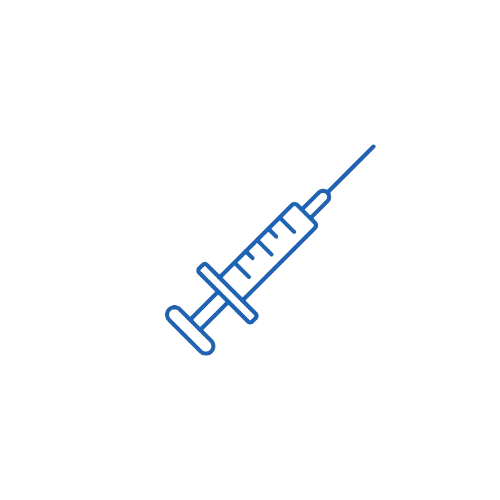Erythropoietin Beta
Indications
Approved Indications:
- Anemia in Chronic Kidney Disease (CKD):
- Treatment of anemia in adult and pediatric patients with CKD, both on dialysis and not on dialysis.
- Anemia in Cancer Patients Receiving Chemotherapy:
- Indicated for anemia due to myelosuppressive chemotherapy in patients with non-myeloid malignancies.
- Prevention of Allogeneic Blood Transfusion:
- Used to reduce the need for allogeneic red blood cell transfusions in anemic patients scheduled for elective surgery.
- Anemia Associated with Zidovudine Treatment in HIV-infected Patients:
- Used in patients with zidovudine-induced anemia and serum erythropoietin ≤500 mUnits/mL.
Off-Label/Clinically Accepted Uses:
- Myelodysplastic Syndromes (MDS):
- Management of anemia in low-risk MDS patients.
- Anemia in Premature Neonates:
- Occasionally administered to reduce transfusion requirements in NICU patients.
Dosage & Administration
Administration Route: Intravenous (IV) or Subcutaneous (SC) injection.
General Principle: Use the lowest effective dose to achieve target hemoglobin and reduce transfusion needs. Monitor hemoglobin regularly.
Adults with CKD on Dialysis:
- Initial dose: 50–100 units/kg SC/IV, 3 times per week.
- Adjustment: Increase or decrease by 25% every 4 weeks based on hemoglobin response.
Adults with CKD not on Dialysis:
- Initial dose: 50–100 units/kg SC/IV once to three times per week.
- Alternative: 10,000 units SC once weekly.
Pediatric CKD Patients:
- Initial dose: 50 units/kg SC/IV 3 times weekly.
- Adjust according to hemoglobin response.
Chemotherapy-Induced Anemia:
- Dose: 150 units/kg SC three times weekly or 40,000 units SC once weekly.
- Duration: Discontinue if no response after 8 weeks.
Zidovudine-Induced Anemia:
- 100 units/kg IV/SC three times weekly.
Surgical Patients (Reduction of Transfusion):
- 300 units/kg/day SC for 10 days pre-surgery, day of surgery, and 4 days post-surgery.
- Or 600 units/kg SC weekly for 3 weeks before surgery and on day of surgery.
Special Populations:
- Renal Impairment: Dose titration based on hemoglobin target.
- Hepatic Impairment: Caution advised; no clear adjustments recommended.
- Elderly: No standard dosage adjustment; monitor response closely.
Mechanism of Action (MOA)
Erythropoietin beta is a recombinant human erythropoietin that stimulates erythropoiesis. It binds specifically to erythropoietin receptors on erythroid progenitor cells in the bone marrow, activating the JAK2/STAT5 signaling pathway. This triggers proliferation and differentiation of committed erythroid progenitors into mature red blood cells, increasing reticulocyte counts, hemoglobin levels, and hematocrit. The resulting enhancement of red cell production alleviates anemia and reduces the need for transfusions.
Pharmacokinetics
- Absorption: SC bioavailability ~20–30%; peak plasma levels occur 12–18 hours post-injection.
- Distribution: Low volume of distribution (~0.04 L/kg), primarily within plasma.
- Metabolism: Cleared mainly by liver and kidneys; degraded into peptides and amino acids.
- Elimination:
- Half-life: IV 4–13 hours, SC 18–25 hours.
- Minimal unchanged drug excreted in urine; elimination primarily via catabolism.
Pregnancy Category & Lactation
- Pregnancy: FDA Category C; animal studies show fetal risk, human data are limited. Use only if benefit outweighs risk.
- Lactation: Unknown if excreted in human milk. Caution is advised; monitor infant if used during breastfeeding.
Therapeutic Class
- Primary Class: Erythropoiesis-Stimulating Agent (ESA)
- Subclass: Recombinant Human Erythropoietin (rhEPO), Glycoprotein Hormone
Contraindications
- Hypersensitivity to erythropoietin beta or excipients
- Uncontrolled hypertension
- Pure red cell aplasia (PRCA) following ESA therapy
- Severe allergic reactions to albumin or mammalian cell-derived products
- Recent surgery without prophylactic anticoagulation
Warnings & Precautions
- Mortality & Tumor Progression: ESA use in cancer patients may increase risk; limit use to chemotherapy-induced anemia.
- Cardiovascular Events: Increased risk of stroke, thromboembolism, and myocardial infarction, especially if hemoglobin >11 g/dL.
- Hypertension: Monitor and control before therapy.
- Seizures: Risk during early therapy.
- PRCA: Rare but serious; discontinue permanently if suspected.
- Monitoring: Hemoglobin every 1–2 weeks initially, blood pressure, iron status.
Side Effects
Common:
- Hematologic: Hypertension, thrombosis, headache
- Gastrointestinal: Nausea, vomiting, diarrhea
- Musculoskeletal: Arthralgia, myalgia
- General: Fatigue, fever, injection site reactions
Serious/Rare:
- Pure red cell aplasia (PRCA)
- Seizures
- Myocardial infarction, stroke
- Tumor progression in cancer patients
Timing & Dose Dependence: Most adverse effects occur within weeks; severity may increase with higher doses.
Drug Interactions
- Cyclosporine: May reduce ESA efficacy.
- Iron Supplements: Required for optimal response; deficiency reduces efficacy.
- ACE Inhibitors/ARBs: Can blunt hematopoietic response.
- Aluminum-containing antacids: May impair bone marrow response.
CYP450: Not metabolized via CYP450; no clinically significant interactions expected.
Recent Updates or Guidelines
- FDA Guidance: Use lowest effective dose; emphasize hemoglobin-based individualized dosing.
- Black Box Warning Updates: Cancer-related anemia warning strengthened for mortality and tumor progression risk.
- NICE & KDIGO: Recommend ESA therapy only at Hb <10 g/dL in CKD, with careful iron monitoring.
Storage Conditions
- Temperature: 2°C to 8°C; do not freeze
- Light: Protect from light; keep in original package
- Handling: Do not shake; discard if discolored or particulate matter present
- Reconstitution: Not applicable for prefilled syringes; administer immediately once opened
